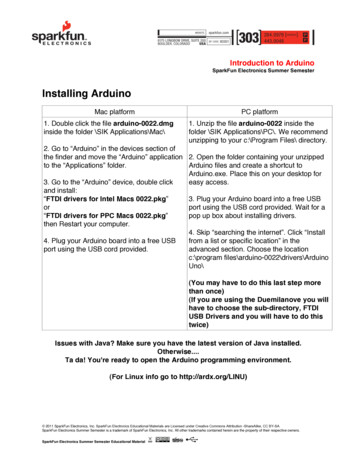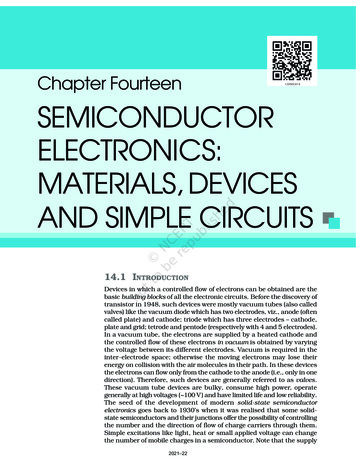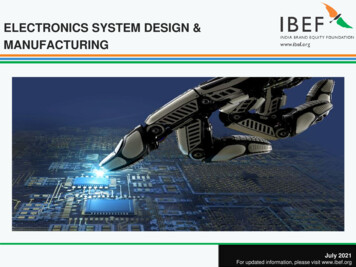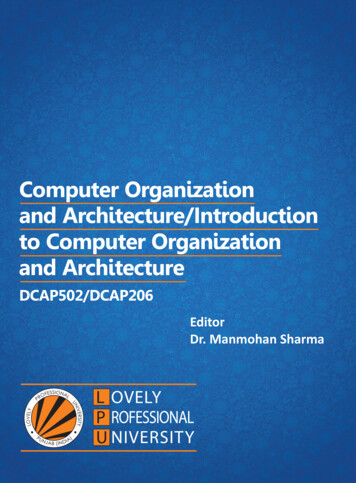
Transcription
Digital ElectronicsDigital Electronics: Principles, Devices and Applications Anil K. Maini 2007 John Wiley & Sons, Ltd. ISBN: 978-0-470-03214-5
Digital ElectronicsPrinciples, Devices and ApplicationsAnil K. MainiDefence Research and Development Organization (DRDO), India
Copyright 2007John Wiley & Sons Ltd, The Atrium, Southern Gate, Chichester,West Sussex PO19 8SQ, EnglandTelephone 44 1243 779777Email (for orders and customer service enquiries): cs-books@wiley.co.ukVisit our Home Page on www.wiley.comAll Rights Reserved. No part of this publication may be reproduced, stored in a retrieval system or transmitted inany form or by any means, electronic, mechanical, photocopying, recording, scanning or otherwise, except underthe terms of the Copyright, Designs and Patents Act 1988 or under the terms of a licence issued by the CopyrightLicensing Agency Ltd, 90 Tottenham Court Road, London W1T 4LP, UK, without the permission in writing ofthe Publisher. Requests to the Publisher should be addressed to the Permissions Department, John Wiley & SonsLtd, The Atrium, Southern Gate, Chichester, West Sussex PO19 8SQ, England, or emailed topermreq@wiley.co.uk, or faxed to ( 44) 1243 770620.Designations used by companies to distinguish their products are often claimed as trademarks. All brand namesand product names used in this book are trade names, service marks, trademarks or registered trademarks of theirrespective owners. The Publisher is not associated with any product or vendor mentioned in this book.This publication is designed to provide accurate and authoritative information in regard to the subject mattercovered. It is sold on the understanding that the Publisher is not engaged in rendering professional services. Ifprofessional advice or other expert assistance is required, the services of a competent professional should besought.Other Wiley Editorial OfficesJohn Wiley & Sons Inc., 111 River Street, Hoboken, NJ 07030, USAJossey-Bass, 989 Market Street, San Francisco, CA 94103-1741, USAWiley-VCH Verlag GmbH, Boschstr. 12, D-69469 Weinheim, GermanyJohn Wiley & Sons Australia Ltd, 42 McDougall Street, Milton, Queensland 4064, AustraliaJohn Wiley & Sons (Asia) Pte Ltd, 2 Clementi Loop #02-01, Jin Xing Distripark, Singapore 129809John Wiley & Sons Canada Ltd, 6045 Freemont Blvd, Mississauga, ONT, Canada L5R 4J3Wiley also publishes its books in a variety of electronic formats. Some content that appears in print may not beavailable in electronic books.Anniversary Logo Design: Richard J. PacificoLibrary of Congress Cataloging in Publication DataMaini, Anil Kumar.Digital electronics : principles, devices, and applications / Anil Kumar Maini.p. cm.Includes bibliographical references and index.ISBN 978-0-470-03214-5 (Cloth)1. Digital electronics. I. Title.TK7868.D5M275 2007621.381—dc222007020666British Library Cataloguing in Publication DataA catalogue record for this book is available from the British LibraryISBN 978-0-470-03214-5 (HB)Typeset in 9/11pt Times by Integra Software Services Pvt. Ltd, Pondicherry, IndiaPrinted and bound in Great Britain by Antony Rowe Ltd, Chippenham, WiltshireThis book is printed on acid-free paper responsibly manufactured from sustainable forestry in whichat least two trees are planted for each one used for paper production.
In the loving memory of my father, Shri Sukhdev Raj Maini, who has been a source ofinspiration, courage and strength to me to face all challenges in life, and above all instilledin me the value of helping people to make this world a better place.Anil K. Maini
121313Number Systems1.1Analogue Versus Digital1.2Introduction to Number Systems1.3Decimal Number System1.4Binary Number System1.4.1Advantages1.5Octal Number System1.6Hexadecimal Number System1.7Number Systems – Some Common Terms1.7.1Binary Number System1.7.2Decimal Number System1.7.3Octal Number System1.7.4Hexadecimal Number System1.8Number Representation in Binary1.8.1Sign-Bit Magnitude1.8.21’s Complement1.8.32’s Complement1.9Finding the Decimal Equivalent1.9.1Binary-to-Decimal Conversion1.9.2Octal-to-Decimal Conversion1.9.3Hexadecimal-to-Decimal Conversion1.10 Decimal-to-Binary Conversion1.11 Decimal-to-Octal Conversion1.12 Decimal-to-Hexadecimal Conversion1.13 Binary–Octal and Octal–Binary Conversions1.14 Hex–Binary and Binary–Hex Conversions1.15 Hex–Octal and Octal–Hex Conversions1.16 The Four Axioms1.17 Floating-Point Numbers1.17.1 Range of Numbers and Precision1.17.2 Floating-Point Number Formats
ContentsviiiReview QuestionsProblemsFurther Reading1717182Binary Codes2.1 Binary Coded Decimal2.1.1 BCD-to-Binary Conversion2.1.2 Binary-to-BCD Conversion2.1.3 Higher-Density BCD Encoding2.1.4 Packed and Unpacked BCD Numbers2.2 Excess-3 Code2.3 Gray Code2.3.1 Binary–Gray Code Conversion2.3.2 Gray Code–Binary Conversion2.3.3 n-ary Gray Code2.3.4 Applications2.4 Alphanumeric Codes2.4.1 ASCII code2.4.2 EBCDIC code2.4.3 Unicode2.5 Seven-segment Display Code2.6 Error Detection and Correction Codes2.6.1 Parity Code2.6.2 Repetition Code2.6.3 Cyclic Redundancy Check Code2.6.4 Hamming CodeReview QuestionsProblemsFurther 24445453Digital Arithmetic3.1 Basic Rules of Binary Addition and Subtraction3.2 Addition of Larger-Bit Binary Numbers3.2.1 Addition Using the 2’s Complement Method3.3 Subtraction of Larger-Bit Binary Numbers3.3.1 Subtraction Using 2’s Complement Arithmetic3.4 BCD Addition and Subtraction in Excess-3 Code3.4.1 Addition3.4.2 Subtraction3.5 Binary Multiplication3.5.1 Repeated Left-Shift and Add Algorithm3.5.2 Repeated Add and Right-Shift Algorithm3.6 Binary Division3.6.1 Repeated Right-Shift and Subtract Algorithm3.6.2 Repeated Subtract and Left-Shift Algorithm3.7 Floating-Point Arithmetic3.7.1 Addition and Subtraction3.7.2 Multiplication and Division474749495253575757585959606162646565
ContentsixReview QuestionsProblemsFurther 124.134.145Gates and Related DevicesPositive and Negative LogicTruth TableLogic Gates4.3.1OR Gate4.3.2AND Gate4.3.3NOT Gate4.3.4EXCLUSIVE-OR Gate4.3.5NAND Gate4.3.6NOR Gate4.3.7EXCLUSIVE-NOR Gate4.3.8INHIBIT GateUniversal GatesGates with Open Collector/Drain OutputsTristate Logic GatesAND-OR-INVERT GatesSchmitt GatesSpecial Output GatesFan-Out of Logic GatesBuffers and TransceiversIEEE/ANSI Standard Symbols4.12.1 IEEE/ANSI Standards – Salient Features4.12.2 ANSI Symbols for Logic Gate ICsSome Common Applications of Logic Gates4.13.1 OR Gate4.13.2 AND Gate4.13.3 EX-OR/EX-NOR Gate4.13.4 InverterApplication-Relevant InformationReview QuestionsProblemsFurther ReadingLogic Families5.1Logic Families – Significance and Types5.1.1Significance5.1.2Types of Logic Family5.2Characteristic Parameters5.3Transistor Transistor Logic (TTL)5.3.1Standard TTL5.3.2Other Logic Gates in Standard TTL5.3.3Low-Power TTL5.3.4High-Power TTL (74H/54H)5.3.5Schottky TTL 116118124125127133134135
3.6Low-Power Schottky TTL (74LS/54LS)5.3.7Advanced Low-Power Schottky TTL (74ALS/54ALS)5.3.8Advanced Schottky TTL (74AS/54AS)5.3.9Fairchild Advanced Schottky TTL (74F/54F)5.3.10 Floating and Unused Inputs5.3.11 Current Transients and Power Supply DecouplingEmitter Coupled Logic (ECL)5.4.1Different Subfamilies5.4.2Logic Gate Implementation in ECL5.4.3Salient Features of ECLCMOS Logic Family5.5.1Circuit Implementation of Logic Functions5.5.2CMOS SubfamiliesBiCMOS Logic5.6.1BiCMOS Inverter5.6.2BiCMOS NANDNMOS and PMOS Logic5.7.1PMOS Logic5.7.2NMOS LogicIntegrated Injection Logic (I2 L) FamilyComparison of Different Logic FamiliesGuidelines to Using TTL DevicesGuidelines to Handling and Using CMOS DevicesInterfacing with Different Logic Families5.12.1 CMOS-to-TTL Interface5.12.2 TTL-to-CMOS Interface5.12.3 TTL-to-ECL and ECL-to-TTL Interfaces5.12.4 CMOS-to-ECL and ECL-to-CMOS InterfacesClassification of Digital ICsApplication-Relevant InformationReview QuestionsProblemsFurther ReadingBoolean Algebra and Simplification Techniques6.1Introduction to Boolean Algebra6.1.1Variables, Literals and Terms in Boolean Expressions6.1.2Equivalent and Complement of Boolean Expressions6.1.3Dual of a Boolean Expression6.2Postulates of Boolean Algebra6.3Theorems of Boolean Algebra6.3.1Theorem 1 (Operations with ‘0’ and ‘1’)6.3.2Theorem 2 (Operations with ‘0’ and ‘1’)6.3.3Theorem 3 (Idempotent or Identity Laws)6.3.4Theorem 4 (Complementation Law)6.3.5Theorem 5 (Commutative Laws)6.3.6Theorem 6 (Associative Laws)6.3.7Theorem 7 (Distributive 5187189189190190191192192192193193193194194195
Contents6.46.56.67xi6.3.8Theorem 86.3.9Theorem 96.3.10 Theorem 10 (Absorption Law or Redundancy Law)6.3.11 Theorem 116.3.12 Theorem 12 (Consensus Theorem)6.3.13 Theorem 13 (DeMorgan’s Theorem)6.3.14 Theorem 14 (Transposition Theorem)6.3.15 Theorem 156.3.16 Theorem 166.3.17 Theorem 17 (Involution Law)Simplification Techniques6.4.1Sum-of-Products Boolean Expressions6.4.2Product-of-Sums Expressions6.4.3Expanded Forms of Boolean Expressions6.4.4Canonical Form of Boolean Expressions6.4.5 and NomenclatureQuine–McCluskey Tabular Method6.5.1Tabular Method for Multi-Output FunctionsKarnaugh Map Method6.6.1Construction of a Karnaugh Map6.6.2Karnaugh Map for Boolean Expressions with a Larger Number ofVariables6.6.3Karnaugh Maps for Multi-Output FunctionsReview QuestionsProblemsFurther ReadingArithmetic Circuits7.1Combinational Circuits7.2Implementing Combinational Logic7.3Arithmetic Circuits – Basic Building Blocks7.3.1Half-Adder7.3.2Full Adder7.3.3Half-Subtractor7.3.4Full Subtractor7.3.5Controlled Inverter7.4Adder–Subtractor7.5BCD Adder7.6Carry Propagation–Look-Ahead Carry Generator7.7Arithmetic Logic Unit (ALU)7.8Multipliers7.9Magnitude Comparator7.9.1Cascading Magnitude Comparators7.10 Application-Relevant InformationReview QuestionsProblemsFurther 240242244245246254260260261263266266267268
Contentsxii89Multiplexers and Demultiplexers8.1Multiplexer8.1.1Inside the Multiplexer8.1.2Implementing Boolean Functions withMultiplexers8.1.3Multiplexers for Parallel-to-Serial Data Conversion8.1.4Cascading Multiplexer Circuits8.2Encoders8.2.1Priority Encoder8.3Demultiplexers and Decoders8.3.1Implementing Boolean Functions with Decoders8.3.2Cascading Decoder Circuits8.4Application-Relevant InformationReview QuestionsProblemsFurther 98Programmable Logic Devices9.1Fixed Logic Versus Programmable Logic9.1.1Advantages and Disadvantages9.2Programmable Logic Devices – An Overview9.2.1Programmable ROMs9.2.2Programmable Logic Array9.2.3Programmable Array Logic9.2.4Generic Array Logic9.2.5Complex Programmable Logic Device9.2.6Field-Programmable Gate Array9.3Programmable ROMs9.4Programmable Logic Array9.5Programmable Array Logic9.5.1PAL Architecture9.5.2PAL Numbering System9.6Generic Array Logic9.7Complex Programmable Logic Devices9.7.1Internal Architecture9.7.2Applications9.8Field-Programmable Gate Arrays9.8.1Internal Architecture9.8.2Applications9.9Programmable Interconnect Technologies9.9.1Fuse9.9.2Floating-Gate Transistor Switch9.9.3Static RAM-Controlled Programmable Switches9.9.4Antifuse9.10 Design and Development of Programmable Logic Hardware9.11 Programming Languages9.11.1 ABEL-Hardware Description Language9.11.2 VHDL-VHSIC Hardware Description 9
Contents9.1210xiii9.11.3Verilog9.11.4Java HDLApplication Information on PLDs9.12.1SPLDs9.12.2CPLDs9.12.3FPGAsReview QuestionsProblemsFurther ReadingFlip-Flops and Related Devices10.1Multivibrator10.1.1Bistable Multivibrator10.1.2Schmitt Trigger10.1.3Monostable Multivibrator10.1.4Astable Multivibrator10.2Integrated Circuit (IC) Multivibrators10.2.1Digital IC-Based Monostable Multivibrator10.2.2IC Timer-Based Multivibrators10.3R-S Flip-Flop10.3.1R-S Flip-Flop with Active LOW Inputs10.3.2R-S Flip-Flop with Active HIGH Inputs10.3.3Clocked R-S Flip-Flop10.4Level-Triggered and Edge-Triggered Flip-Flops10.5J -K Flip-Flop10.5.1J -K Flip-Flop with PRESET and CLEAR Inputs10.5.2Master–Slave Flip-Flops10.6Toggle Flip-Flop (T Flip-Flop)10.6.1J-K Flip-Flop as a Toggle Flip-Flop10.7D Flip-Flop10.7.1J -K Flip-Flop as D Flip-Flop10.7.2D Latch10.8Synchronous and Asynchronous Inputs10.9Flip-Flop Timing Parameters10.9.1Set-Up and Hold Times10.9.2Propagation Delay10.9.3Clock Pulse HIGH and LOW Times10.9.4Asynchronous Input Active Pulse Width10.9.5Clock Transition Times10.9.6Maximum Clock Frequency10.10 Flip-Flop Applications10.10.1 Switch Debouncing10.10.2 Flip-Flop Synchronization10.10.3 Detecting the Sequence of Edges10.11 Application-Relevant DataReview QuestionsProblemsFurther 398399399399401401402402402402404404407408409410
Contentsxiv11Counters and Registers11.1Ripple (Asynchronous) Counter11.1.1Propagation Delay in Ripple Counters11.2Synchronous Counter11.3Modulus of a Counter11.4Binary Ripple Counter – Operational Basics11.4.1Binary Ripple Counters with a Modulus of Less than 2N11.4.2Ripple Counters in IC Form11.5Synchronous (or Parallel) Counters11.6UP/DOWN Counters11.7Decade and BCD Counters11.8Presettable Counters11.8.1Variable Modulus with Presettable Counters11.9Decoding a Counter11.10 Cascading Counters11.10.1 Cascading Binary Counters11.10.2 Cascading BCD Counters11.11 Designing Counters with Arbitrary Sequences11.11.1 Excitation Table of a Flip-Flop11.11.2 State Transition Diagram11.11.3 Design Procedure11.12 Shift Register11.12.1 Serial-In Serial-Out Shift Register11.12.2 Serial-In Parallel-Out Shift Register11.12.3 Parallel-In Serial-Out Shift Register11.12.4 Parallel-In Parallel-Out Shift Register11.12.5 Bidirectional Shift Register11.12.6 Universal Shift Register11.13 Shift Register Counters11.13.1 Ring Counter11.13.2 Shift Counter11.14 IEEE/ANSI Symbology for Registers and Counters11.14.1 Counters11.14.2 Registers11.15 Application-Relevant InformationReview QuestionsProblemsFurther 46446446646646646947112Data Conversion Circuits – D/A and A/D Converters12.1Digital-to-Analogue Converters12.1.1Simple Resistive Divider Network for D/A Conversion12.1.2Binary Ladder Network for D/A Conversion12.2D/A Converter Conversion Speed or Settling Time12.2.4Dynamic Range473473474475476476477477478
.2.5Nonlinearity and Differential Nonlinearity12.2.6MonotonocityTypes of D/A Converter12.3.1Multiplying D/A Converters12.3.2Bipolar-Output D/A Converters12.3.3Companding D/A ConvertersModes of Operation12.4.1Current Steering Mode of Operation12.4.2Voltage Switching Mode of OperationBCD-Input D/A ConverterIntegrated Circuit D/A .6.4AD 752412.6.5DAC-1408/DAC-1508D/A Converter Applications12.7.1D/A Converter as a Multiplier12.7.2D/A converter as a Divider12.7.3Programmable Integrator12.7.4Low-Frequency Function Generator12.7.5Digitally Controlled FiltersA/D ConvertersA/D Converter Gain and Offset Errors12.9.4Gain and Offset Drifts12.9.5Sampling Frequency and Aliasing Phenomenon12.9.6Quantization Error12.9.7Nonlinearity12.9.8Differential Nonlinearity12.9.9Conversion Time12.9.10 Aperture and Acquisition Times12.9.11 Code WidthA/D Converter Terminology12.10.1 Unipolar Mode Operation12.10.2 Bipolar Mode Operation12.10.3 Coding12.10.4 Low Byte and High Byte12.10.5 Right-Justified Data, Left-Justified Data12.10.6 Command Register, Status Register12.10.7 Control LinesTypes of A/D Converter12.11.1 Simultaneous or Flash A/D Converters12.11.2 Half-Flash A/D Converter12.11.3 Counter-Type A/D Converter12.11.4 Tracking-Type A/D 505
Contentsxvi12.11.5 Successive Approximation Type A/D Converter12.11.6 Single-, Dual- and Multislope A/D Converters12.11.7 Sigma-Delta A/D ConverterIntegrated Circuit A/D Converters12.12.1 ADC-080012.12.2 ADC-080812.12.3 ADC-80/AD ADC-8012.12.4 ADC-84/ADC-85/AD ADC-84/AD ADC-85/AD-524012.12.5 AD 782012.12.6 ICL 7106/ICL 7107A/D Converter Applications12.13.1 Data AcquisitionReview QuestionsProblemsFurther 23Microprocessors13.1Introduction to Microprocessors13.2Evolution of Microprocessors13.3Inside a Microprocessor13.3.1Arithmetic Logic Unit (ALU)13.3.2Register File13.3.3Control Unit13.4Basic Microprocessor Instructions13.4.1Data Transfer Instructions13.4.2Arithmetic Instructions13.4.3Logic Instructions13.4.4Control Transfer or Branch or Program Control Instructions13.4.5Machine Control Instructions13.5Addressing Modes13.5.1Absolute or Memory Direct Addressing Mode13.5.2Immediate Addressing Mode13.5.3Register Direct Addressing Mode13.5.4Register Indirect Addressing Mode13.5.5Indexed Addressing Mode13.5.6Implicit Addressing Mode and Relative Addressing Mode13.6Microprocessor Selection13.6.1Selection Criteria13.6.2Microprocessor Selection Table for Common Applications13.7Programming Microprocessors13.8RISC Versus CISC Processors13.9Eight-Bit Microprocessors13.9.18085 Microprocessor13.9.2Motorola 6800 Microprocessor13.9.3Zilog Z80 Microprocessor13.10 16-Bit Microprocessors13.10.1 8086 Microprocessor13.10.2 80186 654754754812.1212.1313
Contents13.10.380286 Microprocessor13.10.4MC68000 Microprocessor32-Bit Microprocessors13.11.180386 Microprocessor13.11.2MC68020 Microprocessor13.11.3MC68030 Microprocessor13.11.480486 Microprocessor13.11.5PowerPC RISC MicroprocessorsPentium Series of Microprocessors13.12.1Salient Features13.12.2Pentium Pro Microprocessor13.12.3Pentium II Series13.12.4Pentium III and Pentium IV Microprocessors13.12.5Pentium M, D and Extreme Edition Processors13.12.6Celeron and Xeon ProcessorsMicroprocessors for Embedded ApplicationsPeripheral Devices13.14.1Programmable Timer/Counter13.14.2Programmable Peripheral Interface13.14.3Programmable Interrupt Controller13.14.4DMA Controller13.14.5Programmable Communication Interface13.14.6Math Coprocessor13.14.7Programmable Keyboard/Display Interface13.14.8Programmable CRT Controller13.14.9Floppy Disk Controller13.14.10 Clock Generator13.14.11 Octal Bus TransceiverReview QuestionsFurther rocontrollers14.1Introduction to the Microcontroller14.1.1Applications14.2Inside the Microcontroller14.2.1Central Processing Unit (CPU)14.2.2Random Access Memory (RAM)14.2.3Read Only Memory (ROM)14.2.4Special-Function Registers14.2.5Peripheral Components14.3Microcontroller Architecture14.3.1Architecture to Access Memory14.3.2Mapping Special-Function Registers into Memory Space14.3.3Processor Architecture14.4Power-Saving Modes14.5Application-Relevant Information14.5.1Eight-Bit Microcontrollers14.5.216-Bit 7657757958058058813.1113.1213.1313.1414xvii
Contentsxviii14.61514.5.332-Bit MicrocontrollersInterfacing Peripheral Devices with a Microcontroller14.6.1Interfacing LEDs14.6.2Interfacing Electromechanical Relays14.6.3Interfacing Keyboards14.6.4Interfacing Seven-Segment Displays14.6.5Interfacing LCD Displays14.6.6Interfacing A/D Converters14.6.7Interfacing D/A ConvertersReview QuestionsProblemsFurther ReadingComputer Fundamentals15.1Anatomy of a Computer15.1.1Central Processing Unit15.1.2Memory15.1.3Input/Output Ports15.2A Computer System15.3Types of Computer System15.3.1Classification of Computers on the Basis of Applications15.3.2Classification of Computers on the Basis of the Technology Used15.3.3Classification of Computers on the Basis of Size and Capacity15.4Computer Memory15.4.1Primary Memory15.5Random Access Memory15.5.1Static RAM15.5.2Dynamic RAM15.5.3RAM Applications15.6Read Only Memory15.6.1ROM Architecture15.6.2Types of ROM15.6.3Applications of ROMs15.7Expanding Memory Capacity15.7.1Word Size Expansion15.7.2Memory Location Expansion15.8Input and Output Ports15.8.1Serial Ports15.8.2Parallel Ports15.8.3Internal Buses15.9Input/Output Devices15.9.1Input Devices15.9.2Output Devices15.10 Secondary Storage or Auxiliary Storage15.10.1 Magnetic Storage Devices15.10.2 Magneto-Optical Storage Devices15.10.3 Optical Storage Devices15.10.4 USB Flash 9632632634637638640642642643643645645648648650
ContentsxixReview QuestionsProblemsFurther Reading16Troubleshooting Digital Circuits and Test Equipment16.1General Troubleshooting Guidelines16.1.1Faults Internal to Digital Integrated Circuits16.1.2Faults External to Digital Integrated Circuits16.2Troubleshooting Sequential Logic Circuits16.3Troubleshooting Arithmetic Circuits16.4Troubleshooting Memory Devices16.4.1Troubleshooting RAM Devices16.4.2Troubleshooting ROM Devices16.5Test and Measuring Equipment16.6Digital Multimeter16.6.1Advantages of Using a Digital Multimeter16.6.2Inside the Digital Meter16.6.3Significance of the Half-Digit16.7Oscilloscope16.7.1Importance of Specifications and Front-Panel Controls16.7.2Types of Oscilloscope16.8Analogue Oscilloscopes16.9CRT Storage Type Analogue Oscilloscopes16.10 Digital Oscilloscopes16.11 Analogue Versus Digital Oscilloscopes16.12 Oscilloscope Specifications16.12.1 Analogue Oscilloscopes16.12.2 Analogue Storage Oscilloscope16.12.3 Digital Storage Oscilloscope16.13 Oscilloscope Probes16.13.1 Probe Compensation16.14 Frequency Counter16.14.1 Universal Counters – Functional Modes16.14.2 Basic Counter Architecture16.14.3 Reciprocal Counters16.14.4 Continuous-Count Counters16.14.5 Counter Specifications16.14.6 Microwave Counters16.15 Frequency Synthesizers and Synthesized Function/Signal Generators16.15.1 Direct Frequency Synthesis16.15.2 Indirect Synthesis16.15.3 Sampled Sine Synthesis (Direct Digital Synthesis)16.15.4 Important Specifications16.15.5 Synthesized Function Generators16.15.6 Arbitrary Waveform Generator16.16 Logic Probe16.17 Logic Analyser16.17.1 Operational 9679681682682683684684685687689689690691692692
Contentsxx16.1816.19Index16.17.2 Logic Analyser Architecture16.17.3 Key SpecificationsComputer–Instrument Interface Standards16.18.1 IEEE-488 InterfaceVirtual Instrumentation16.19.1 Use of Virtual Instruments16.19.2 Components of a Virtual InstrumentReview QuestionsProblemsFurther Reading692695696696697698700703704705707
PrefaceDigital electronics is essential to understanding the design and working of a wide range of applications,from consumer and industrial electronics to communications; from embedded systems, and computersto security and military equipment. As the devices used in these applications decrease in size andemploy more complex technology, it is essential for engineers and students to fully understand boththe fundamentals and also the implementation and application principles of digital electronics, devicesand integrated circuits, thus enabling them to use the most appropriate and effective technique to suittheir technical needs.Digital Electronics: Principles, Devices and Applications is a comprehensive book covering, inone volume, both the fundamentals of digital electronics and the applications of digital devices andintegrated circuits. It is different from similar books on the subject in more than one way. Each chapterin the book, whether it is related to operational fundamentals or applications, is amply illustratedwith diagrams and design examples. In addition, the book covers several new topics, which are ofrelevance to any one having an interest in digital electronics and not covered in the books already inprint on the subject. These include digital troubleshooting, digital instrumentation, programmable logicdevices, microprocessors and microcontrollers. While the book covers in entirety what is required byundergraduate and graduate level students of engineering in electrical, electronics, computer science andinformation technology disciplines, it is intended to be a very useful reference book for professionals,R&D scientists and students at post graduate level.The book is divided into sixteen chapters covering seven major topics. These are: digital electronicsfundamentals (chapters 1 to 6), combinational logic circuits (chapters 7 and 8), programmable logicdevices (chapter 9), sequential logic circuits (chapters 10 and 11), data conversion devices and circuits(chapter 12), microprocessors, microcontrollers and microcomputers (chapters 13 to 15) and digitaltroubleshooting and instrumentation (chapter 16). The contents of each of the sixteen chapters arebriefly described in the following paragraphs.The first six chapters deal with the fundamental topics of digital electronics. These include differentnumber systems that can be used to represent data and binary codes used for representing numeric andalphanumeric data. Conversion from one number system to another and similarly conversion from onecode to another is discussed at length in these chapters. Binary arithmetic, covering different methodsof performing arithmetic operations on binary numbers is discussed next. Chapters four and five coverlogic gates and logic families. The main topics covered in these two chapters are various logic gatesand related devices, different logic families used to hardware implement digital integrated circuits, theinterface between digital ICs belonging to different logic families and application information such
xxiiPrefaceas guidelines for using logic devices of different families. Boolean algebra and its various postulatesand theorems and minimization techniques, providing exhaustive coverage of both Karnaugh mappingand Quine-McCluskey techniques, are discussed in chapter six. The discussion includes application ofthese minimization techniques for multi-output Boolean functions and Boolean functions with largernumber of variables. The concepts underlying different fundamental topics of digital electronics anddiscussed in first six chapters have been amply illustrated with solved examples.As a follow-up to logic gates – the most basic building block of combinational logic – chapters7 and 8 are devoted to more complex combinational logic circuits. While chapter seven coversarithmetic circuits, including different types of adders and subtractors, such as half and full adder andsubtractor, adder-subtractor, larger bit adders and subtractors, multipliers, look ahead carry generator,magnitude comparator, and arithmetic logic unit, chapter eight covers multiplexers, de-multiplexers,encoders and decoders. This is followed by a detailed account of programmable logic devices inchapter nine. Simple programmable logic devices (SPLDs) such as PAL, PLA, GAL and HAL devices,complex programmable logic devices (CPLDs) and field programmable gate arrays (FPGAs) have beenexhaustively treated in terms of their architecture, features and applications. Popular devices, fromvarious international manufacturers, in the three above-mentioned categories of programmable logicdevices are also covered with regard to their architecture, features and facilities.The next two chapters, 10 and 11, cover the sequential logic circuits. Discussion begins with themost fundamental building block of sequential logic, that is, flip flop. Different types of flip flopsare covered in detail with regard to their operational fundamentals, different varieties in each ofthe categories of flip flops and their applications. Multivibrator circuits, being operationally similarto flip flops, are also covered at length in this chapter. Counters and registers are the other veryimportant building blocks of sequential logic with enormous application potential. These are coveredin chapter 11. Particular emphasis is given to timing requirements and design of counters with varyingcount sequence requirements. The chapter also includes a detailed description of the design principlesof counters with arbitrary count sequences. Different types of shift registers and some special countersthat have evolved out of shift registers have been covered in detail.Chapter 12 covers data conversion circuits including digital-to-analogue and analogue-to-digitalconverters. Topics covered in this chapter include operational basics, characteristic parameters, typesand applications. Emphasis is given to definition and interpretation of the terminology and theperformance parameters that characterize these devices. Different types of digital-to-analogue andanalogue-to-digital converters, together with their merits and drawbacks are also addressed. Particularattention is given to their applications. Towards the end of the chapter, application oriented informationin the form of popular type numbers along with their major performance specifications, pin connectiondiagrams etc. is presented. Another highlight of the chapter is the inclusion of detailed descriptions ofnewer types of converters, such as quad slope and sigma-delta types of analogue-to-digital converters.Chapters 13 and 14 discuss microprocessors and microcontrollers – the two versatile devices thathave revolutionized the application potential of digital devices and integrated circuits. The en
Wiley also publishes its books in a variety of electronic formats. Some content that appears in print may not be available in electronic books. Anniversary Logo Design: Richard J. Pacifico Library of Congress Cataloging in Publication Data Maini, Anil Kumar. Digital electronics: princ








![History of Electronics electricity [Read-Only]](/img/18/history-20of-20electronics-20-20electricity.jpg)

